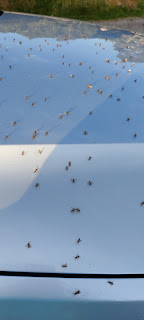It has been a long time since my last post so this will be a bit of a catch up on what has been popping up in the garden. A few more fungi appeared in my lawn. There was the very common Fly Agaric
and some Peppery Bolete which has pores on the underside rather than gills. The yellow end to the stalk is another characteristic. They are said to be edible but I've never tried them.
All mushrooms are just the fruiting bodies of the main part of the fungus which is a web of threads called the mycelium. The Peppery Bolete is parasitic on the mycelium of the Fly Agaric so if you see one, look out for the other.
Another fungus in the lawn
was identified for me by Chris Grimbly who posts on Bluesky as @chrishroom.bsky.social
I thought it was a Panther Cap but apparently the spots need to be whiter than my buff ones. The deciding ID feature is to look at the stalk where there is a white ring (annulus) of floppy material. If it has striations (little ridges) that confirms it is a Blusher, which turns pink when bruised.
The black mark like an anchor on its face means it is a Common Wasp - that's it's name not a judgement! If you look here you can see the faces of the other kinds of wasp.
I also found a ladybird resting on one of the apples. I don't see many ladybirds in spite of there being news items about plagues of ladybirds down south.
It's not a very good picture but instead of black spots it has smeary white ones. It is the Striped Ladybird or Myzia oblongoguttata which overwinters in birch and pine trees (which both grow near the apple tree.)





















































